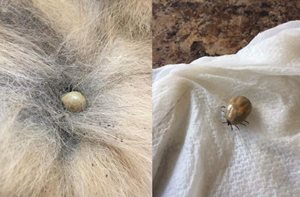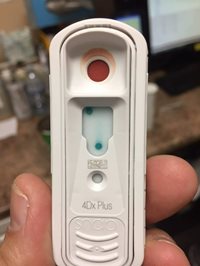Something I never thought I’d write about is my experience with Lyme disease, and that is because I never thought I’d have anything to say. Before entering the veterinary field a year and a half ago, I had little to no knowledge of Lyme disease. Now, I know it all too well. I have seen many snap tests come back positive for the nasty Borrelia burgdorferi, which is the bacteria carried by black-legged ticks that cause Lyme disease.
My Chow Chow named Bear is a lover of the outdoors. There is nothing he enjoys more than spending his time relaxing outside and going for walks on the trail. In 2018, he spent most of his time with my mother who happened to remove some ticks from him in the early Spring. He was on a flea and tick preventative medication, and he had regular tick-checks done. As you can see from his photograph, he is a very fluffy dog, and tick-checks can sometimes miss the tiny, evil things, but that is what flea and tick preventative is for, right? Wrong. It is crucial to know what products are best for your pet, to properly apply them to your pet, and to keep up with these products year-round.
The product Bear was using was applied by the clinic it was purchased at (not my own). My mother trusted that it was the proper weight category for Bear and that it was correctly applied. All that may have been true, but we will never know, and it will not matter now. The product did not hold up to its rumoured benefits. My mother had a strange feeling that we should have Bear seen by a veterinarian at my place of work at the time. He was seen by a veterinarian who happened to find a massive, engorged tick on his front, right leg during the exam which I had no idea was there. It was a week after having his flea and tick, topical preventative applied. The product did not hold up for whatever reason. The sad thing was that this tick was not the first that year. Although the product did not hold up, we also applied it too late as Bear had already been bitten earlier that year. During this exam, I mentioned this to the doctor. The tick we found that day was just your common dog tick, but Bear’s doctor recommended we do bloodwork and a “snap test” (to test him for Lyme disease since we knew his history of being bitten.

Actual tick removed the day of the vet visit at my clinic.
Unfortunately, the snap test came back as positive for Borrelia burgdorferi. Bear had Lyme disease. If the tick we removed that day had caused Lyme disease, the test would not detect it. You have to wait 6-8 weeks after removing a tick from your pet for the test to reflect the positive diagnosis. At that time, your doctor can recommend treatment as he did for Bear. Our next step was antibiotics to fight Lyme disease as best we could and hopefully prevent symptoms. We sent Bear’s blood off to the lab which confirmed it was a recent exposure. We are thankful we caught this early so we could treat early on. Some have no idea this is a good precautionary step rather than waiting until symptoms appear to test for Lyme disease. Sometimes it can make all the difference.


Actual test and a sample of what it means.
A year later, Bear is doing mostly well. He has shown some joint stiffness and less energy, but he is happy and still enjoying his walks, although they are not as intense these days. He is a 13-year old Chow Chow, so whether the old age or Lyme disease is affecting him is a tough call. It could very well be a combination of both that is slowing him down a little. We give Bear his flea and tick prevention all year round. We also thoroughly check for ticks on his skin. While we may have fought off an active infection last year, there is the possibility of new exposure to the bacteria, which would cause the infection again to return. We are thankful this infection was encountered late in his life and not earlier, but we wish we were more careful and educated before this whole scenario.

Tick twisters for proper and safe removal (sold at most clinics).
Now, Bear’s story can help educate other pet owners and encourage them to seek the best possible preventatives to keep their pets safe, including; flea and tick medication, vaccinations, tick checks and tic twisters! If your dog has had ticks removed before, keep an eye out for typical symptoms such as fever, headache, fatigue, and a characteristic skin rash called erythema migrans. Ask your veterinarian what products and or vaccines are best for your pet.
Written by: Brandi Munroe, Lead Client Care Specialist